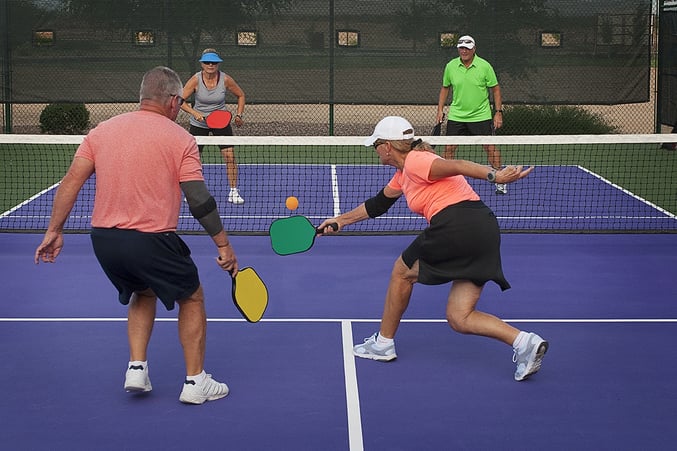Many associations have tennis courts, which are a popular amenity with active adults. However, a new sport is on the rise - pickleball - and only the most recent developments are built to allow space for both.
What is Pickleball?
Pickleball is often described as a cross between tennis and badminton. It was invented in 1965 by two men named Joel Pritchard and Bill Bell, who had bored families, a badminton court, and no badminton equipment. Instead of racquets, they used ping-pong paddles and a plastic ball they had lying around. They decided that they had a good idea and worked on developing the sport, building the first permanent court in 1967.
It is played on a smaller course, similar to a badminton course in size, with a slightly lower net (34" in the middle as opposed to the 3' for tennis). A no-volley zone, the "kitchen," extends for seven feet on either side of the net and the ball has to double bounce before volleys. Serves are done underhand (which puts less strain on the shoulder, making the game more popular with older adults). You can only score on your serve.
The game uses a different ball - a plastic ball between 2 7/8 inches and 3 inches in diameter. The racquets, or "paddles," are smaller and constructed of solid material, generally wood (high-quality competition paddles are constructed of expensive composites). The games are similar enough that a lot of people play both. Like tennis, it can be played in both singles and doubles.
What are the Challenges for Associations?
The primary challenge for associations is to accommodate the demand for pickleball. In most cases, older associations have no space to build new pickleball courts. Badminton courts are close to pickleball courts, but the no-service line is 6.5 feet from the net, and few associations have them.
Converting tennis courts can anger the existing community of tennis players, who are annoyed by the loss of playing space. A better solution is to paint the courts to be used for both sports. If you do, then use a different color for the pickleball lines to reduce the confusion. Some tennis players are still going to find this annoying. If you happen to have badminton courts, then adding a single line to make them pickleball "legal" might be easier than converting tennis courts. Also, remember that you need to make it easy to adjust the net height on mixed-use courts. A tennis net adjuster is the best way to handle this. Another alternative is to have mobile nets, as you can often fit two pickleball courts on a standard tennis court pad. Some people also have temporary barriers that can be moved out during the game to reduce the amount of time spent chasing the balls. If you have two courts, then the net can serve as a backstop. You can sometimes fit four courts in the space.
If you already provide a loan or rental of tennis rackets and balls, then consider adding pickleball paddles and balls to the list. When deciding whether to convert courts permanently or whether to make them multi-use, you should consider both the demand for pickleball and the demand for tennis. If you have tennis courts that are entirely empty and people want to play pickleball, a permanent conversion can be worth the cost. Multi-use courts, however, tend to be cheaper. Moreover, converting to a badminton court can be the cheapest option of all.
Pickleball is a newly popular sport, especially with older adults and relatively young children. Accommodating it is something associations should consider, depending on the demand for tennis and pickleball in their communities. If you need more advice on how to handle the demand for pickleball, or other recreational activities, in a way that keeps costs down and satisfies all of your residents,


